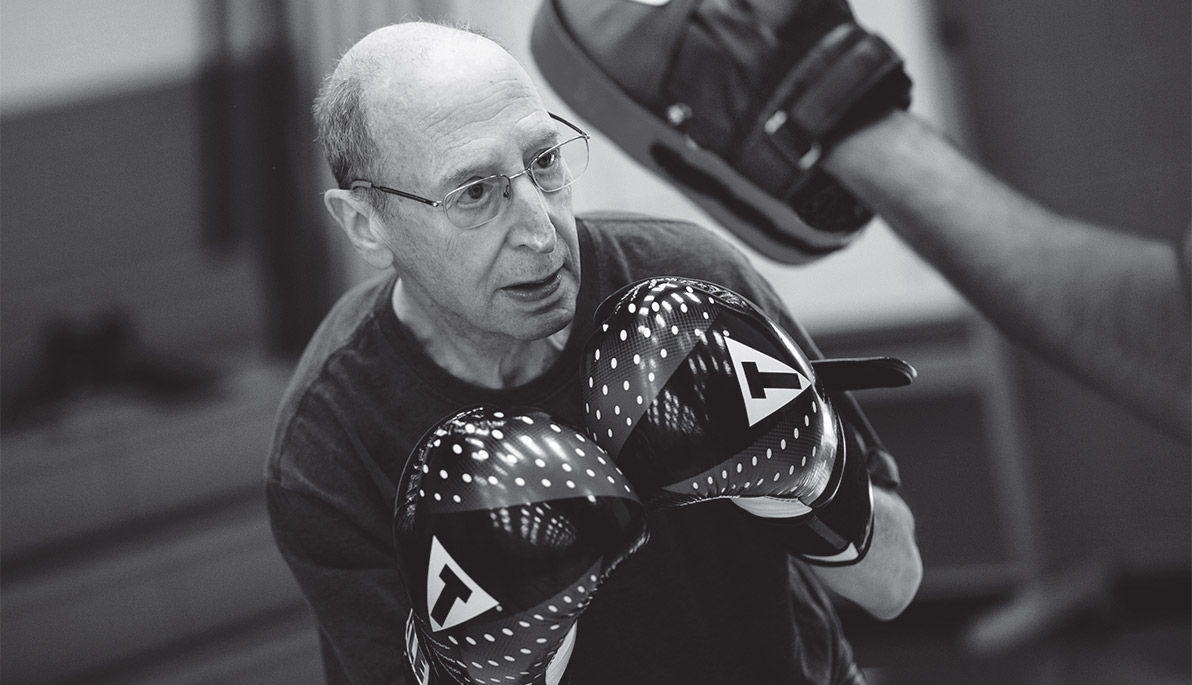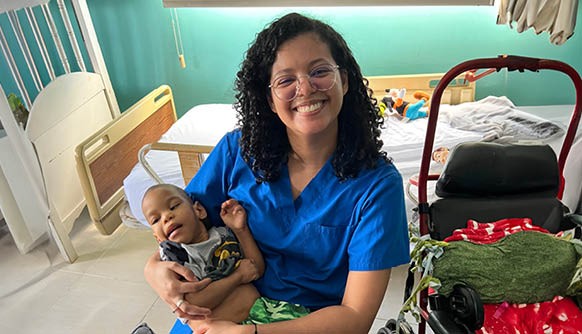News
Boxing in the Fight to Knock Out Parkinson’s
May 30, 2017
Photo: Boxer Paul Shelden works out with a volunteer instructor.
Watch Rock Steady Boxing in action.
In NYIT’s Rock Steady Boxing program, people with Parkinson’s disease are fighting their symptoms and embracing a new community.
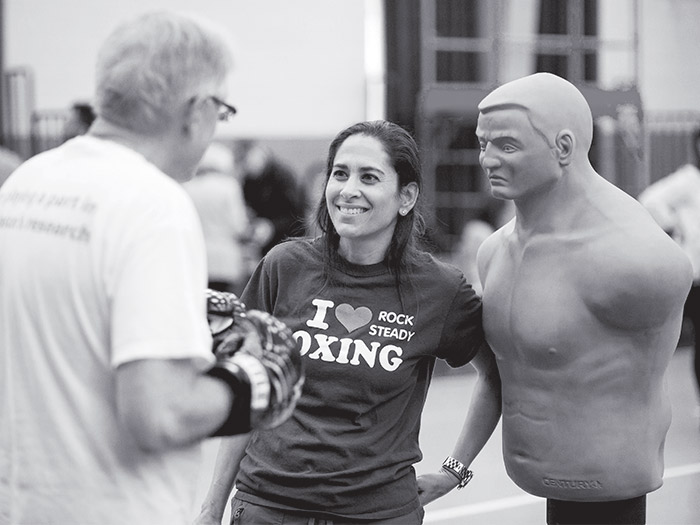
Adena Leder started the program at NYIT.
JACOB MUNN (B.S. ’72) is taking a water break during a Wednesday morning boxing class, one of the several Rock Steady Boxing classes he takes weekly at NYIT-Old Westbury. “It’s pretty rigorous,” says Munn, “I come away sweating.” Munn, who received his degree at NYIT in architectural technology, was diagnosed almost a year ago with Parkinson’s disease. His doctor referred him to Adena Leder (D.O. ’99), a neurologist, movement disorders specialist, and assistant professor at NYIT College of Osteopathic Medicine (NYITCOM). Through Leder, Munn discovered boxing and immediately got hooked. Now he tries to go to class twice a week and wants to increase to three times a week.
Approximately 1 million people in the United States have Parkinson’s disease, and 60,000 are diagnosed with the neurodegenerative brain disorder each year, according to the Parkinson’s Disease Foundation. There is no cure, and patients typically take medication to help control symptoms.
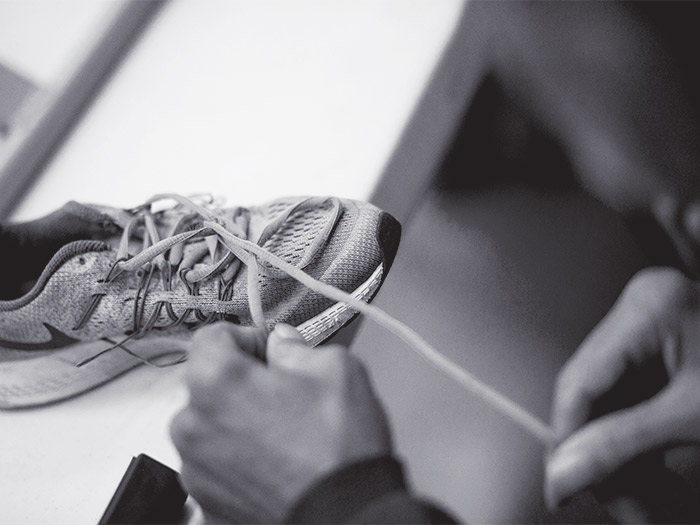
Boxers do exercises, like tying shoes, to help with their symptoms.
Studies show that exercise can help people with Parkinson’s manage symptoms and possibly even slow the progression of the disease. Rock Steady Boxing is putting the studies to the test. The program has been up and running in gyms around the nation for the past 10 years. And the NYIT affiliate, Leder explains, offers additional benefits, including its natural synergy with NYIT’s Adele Smithers Parkinson’s Disease Treatment Center and W. Kenneth Riland Academic Health Care Center.
Hundreds of patients come to NYIT to see a variety of specialists, including physical and occupational therapists, osteopathic physicians, and a speech therapist. Rock Steady now gives them another form of treatment—and fun.
On this Wednesday morning, the gymnasium at NYIT-Old Westbury is a hive of activity with an almost one-to-one ratio of boxers to volunteers, many of whom are students at NYITCOM or NYIT School of Health Professions. Warm-up has begun, and the boxers stand in a semicircle. “I want to see everyone moving. If you don’t have a ball, find one,” instructs Leder.
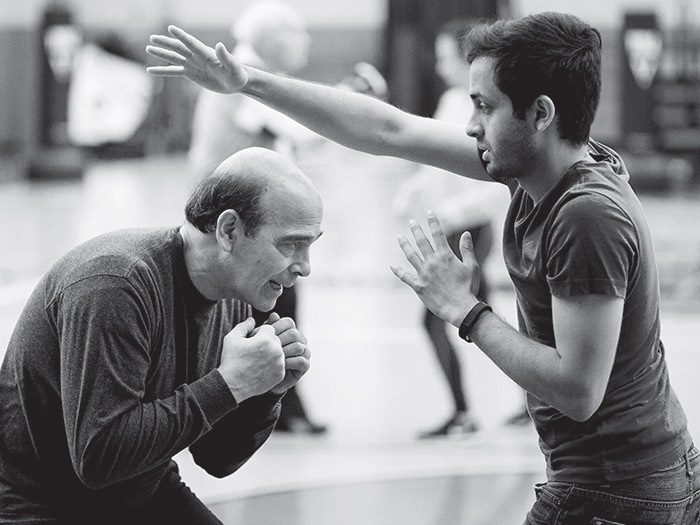
Kirtan Patel (right) with Marc Burns (left), who has Parkinson’s and is also a volunteer instructor.
After kicking balls around, the boxers separate into pairs to work on counterpunching: one boxer practices the one-two punch while the other practices ducking, then they switch (see image left). The volunteers guide and coach the pairs on motion and timing. Then they break into groups to start circuit training—going from station to station with activities that would be challenging for anyone starting an exercise program, including stepping over squares of ropes on the floor while grabbing horizontal ropes in their hands or practicing jabs, stepping on one foot and then the other to tap a rubber tire, and donning boxing gloves to jab at punching bags. Participants also work on fine motor skills and cognitive drills, such as lacing and unlacing shoes and buttoning and unbuttoning shirts while being quizzed on vocabulary.
The room is a combination of serious concentration and friendly banter. At the boxing station, volunteers shout, “Duck, cross, cross, jab.” There is joking and smiling between the student volunteers and the boxers. “Okay, next station,” says Leder, and the groups each move on to the next activity.
Leder heard about the program from a patient at NYIT’s Parkinson’s Disease Treatment Center. In 2016, she and three faculty members at NYITCOM’s Academic Health Care Center—occupational therapist Ling Wan-Albert and physical therapists Kyle Corbett and Shari Gessner—went to the Rock Steady Boxing Indianapolis headquarters to train. “We brought the skills back to NYITCOM and looked for a space,” says Leder.
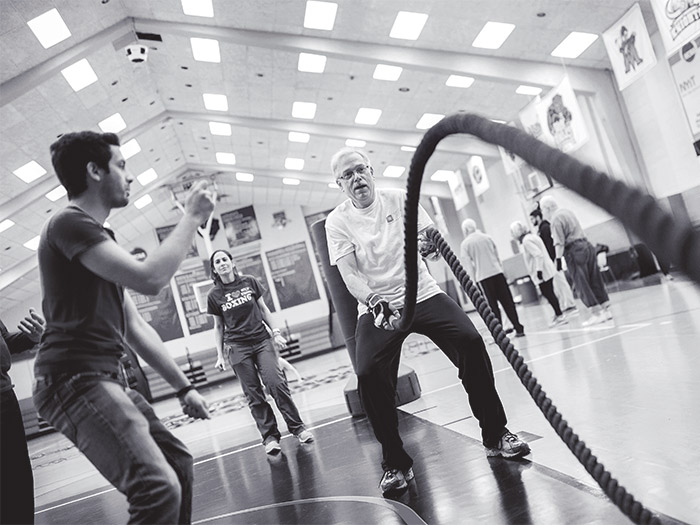
Jacob Munn takes on the ropes with Leder and Patel.
Classes began in early October 2016 and have been growing ever since. There are now four a week—at $20 a class—with 75 registered boxers. The numbers are impressive, considering they haven’t even advertised. “Most participants hear about the program through NYIT’s Adele Smithers Parkinson’s Disease Treatment Center or through a relative or friend,” says Leder. The program offers boxers the added benefit of working with health professionals with different specialties. “We are passionate about helping people with Parkinson’s disease and have years of experience working with this population,” says Wan-Albert. “We are not just one more boxing gym on the street.”
Corbett, who works at the center full-time and runs the Friday boxing class, has become a firm believer in the program. “When we started the training course in Indianapolis, the two directors said that their boxers were in better shape than the room that was full of trainers and physical and occupational therapists. We went through the rigorous course ourselves.”
At first it was a challenge for many of the boxers to get off the ground and to be physically independent, but now after months of the boxing classes, they yell at me if I try to help them up.
Kyle Corbett
As with any exercise program, the beginning wasn’t easy. “We’re trying to develop neuroplasticity through vigorous exercise,” he explains. “At first it was a challenge for many of the boxers to get off the ground and to be physically independent, but now after months of the boxing classes, they yell at me if I try to help them up.” But Corbett also sees how the boxing classes have become more than the exercise. “They help each other develop and push each other to their limits.” He describes how one boxer was having a difficult time standing up by herself. The team helped her focus on core strength building, motor planning, and strategizing which limb to move first and where to place it on the ground. “About four weeks ago, she did it,” says Corbett. “She got up off the ground by herself.”
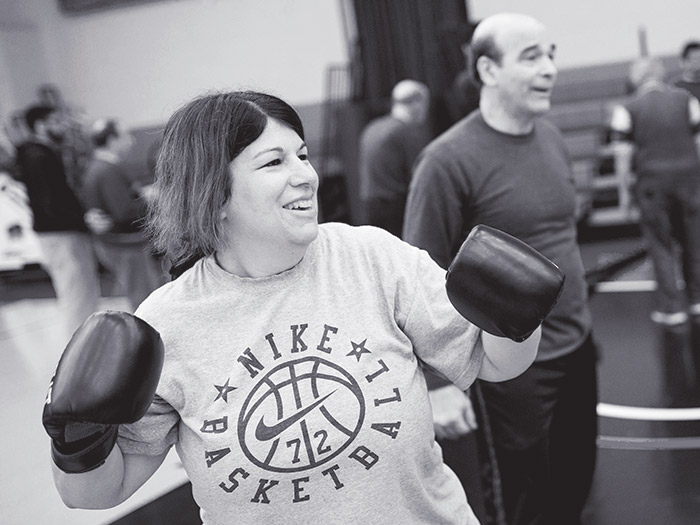
Boxer Mindi Ageloff-Guendel works out with Burns.
Wan-Albert, who leads the Monday boxing class, says many boxers have said to her that they feel empowered by the class. “They really enjoy the group format because when you are working out with people who have similar challenges, you see that you are not alone. This fall, after I taught the class I’d walk back to the Parkinson’s center and see a group of my female boxers having their lunch together at a picnic table by the lake on campus. And I’ve heard the guys have formed a lunch group as well. I didn’t expect that. In the training, I was focused on the moves, the conditioning, and the technique, but I never thought of the social aspect—that’s the greatest surprise.”
The friendships that have resulted from Rock Steady classes is a common denominator that the boxers, instructors, and student volunteers all remark on. “The activity in class helps slow down the disease, keep the muscles going and flexible, and we also do a little cognitive work,” says boxer Munn, “but the best thing about the boxing is the camaraderie that I come away with—meeting people with similar problems and issues. During the session, we are able to talk and push each other and help each other out. We have coffee on Friday after class.”
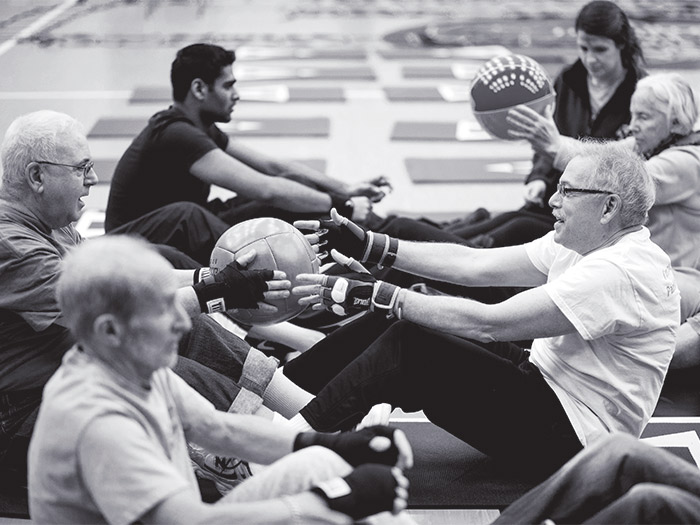
Boxers move between stations doing various activities such as core strengthening and circuit-training exercises.
The experience is also benefiting the NYIT students who volunteer at the classes: “For an osteopathic doctor, who uses a ‘whole-body’ approach to medicine, this couldn’t be a more perfect fit,” says Leder. “The program takes students out of the classroom and shows them how to offer treatment that does not involve medications or surgery.”
For Ummul Asfeen, a first-year student at NYITCOM who started volunteering at the Rock Steady Boxing classes in February, the hands-on involvement with the patients is important. “I go to classes. I read textbooks, but this is real experience.” Asfeen studied medicine in India and was accepted into the NYITCOM Émigré Physicians program, where highly trained doctors from other countries retrain as doctors of osteopathic medicine. The Rock Steady Boxing program, she says, works with the D.O.’s holistic approach to treat the whole human and not just the condition. “We are keeping the patients physically active as well as mentally and providing them with a social life, a community.” says Asfeen, who also has a relative who was diagnosed with Parkinson’s. “I find the program to be personally rewarding,” she adds.
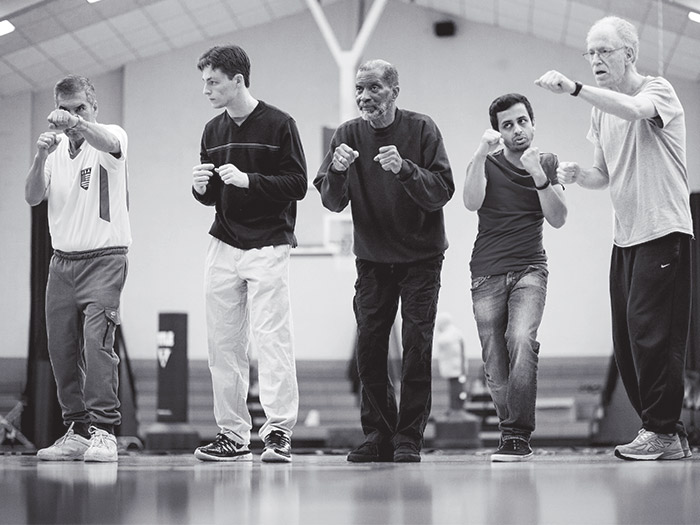
Boxers start each class warming up with volunteers and instructors in a circle.
Kirtan Patel (B.S. ’16), who received his undergraduate degree at NYIT in biology with a health science minor and is currently a first-year student at NYITCOM, initially thought of volunteering as a way to become involved in campus activities, but now he feels the experience has evolved. “The group has become like family to me. We have a special relationship. The boxers ask me how I’m doing, if I’m keeping up with my courses. I didn’t know I would come in and gain a family.”
As the only Rock Steady Boxing affiliate on Long Island, and as the word gets out, the demand for classes is growing. One of Leder’s biggest goals was just realized—the group moved to a permanent space in NYIT de Seversky Mansion this spring. The new space means the instructors no longer need to bring equipment in and out for every class. It’s also further proof of the program’s success.
Learn more about the Adele Smithers Parkinson’s Disease Treatment Center
Back in the gym, boxer Munn says he tries to keep abreast of the treatment and medications and works out several times a week, but for him, “Rock Steady is the big thing right now, and I’ll keep doing it as long as I can.”
This article originally appeared in the Sping 2017 issue of NYIT Magazine. See additional coverage of Rock Steady Boxing at NYIT in Newsday (subscription required): Long Islanders Battle Parkinson's Disease Through NYIT Boxing Program and Rock Steady Boxing Helping Parkinson’s Patients.
